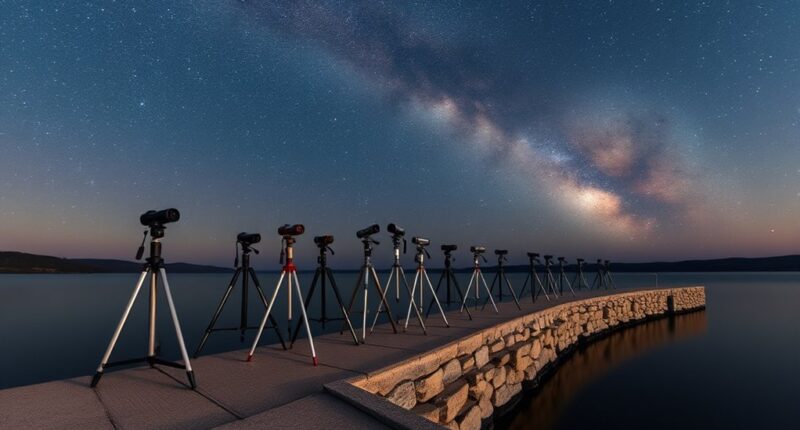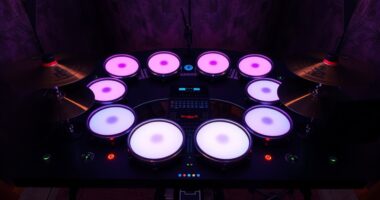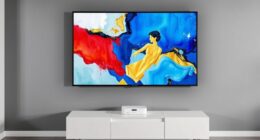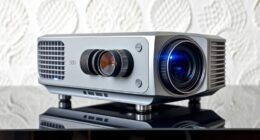Looking to capture stunning astrophotography in 2025? I’ve found that the best tripods and pier mounts combine strong materials, portable designs, and stability features like vibration reduction and adjustable heights. From versatile tripods like Sky-Watcher‘s Star Adventurer to heavy-duty options like Celestron’s Alt-Azimuth tripod, there’s something for every skill level or setup. Keep exploring to discover detailed recommendations and tips that will help you choose the perfect mount to shoot like a pro.
Key Takeaways
- Discover top-rated tripods and pier mounts designed for stability and precision in astrophotography in 2025.
- Learn about versatile, portable mounts with advanced tracking features compatible with smartphones and remote control.
- Find durable heavy-duty tripods and extension supports to minimize vibrations for long-exposure deep space imaging.
- Explore camera mounting solutions for quick setup, multi-camera support, and compatibility with various tripod systems.
- Identify professional-grade mounts and pier supports optimized for stability, ground clearance, and outdoor astrophotography conditions.
Sky Watcher Star Adventurer Tripod

If you’re serious about astrophotography and need a stable platform for your star tracking, the Sky Watcher Star Adventurer Tripod is an excellent choice. It’s compatible with various mounts like the Star Adventurer Mini, GTi, AZ-GT series, and AZ5, making it versatile for different setups. Measuring 36 x 54 x 36 inches and weighing just under 5 pounds, it offers solid stability without adding much weight. Its sturdy design helps guarantee precise star tracking during long exposures. Customers praise its reliability, rating it 4.7 out of 5 stars, and it’s highly regarded among astrophotographers looking to enhance their imaging stability.
Best For: astrophotographers seeking a stable, versatile tripod to support various Sky Watcher mounts for precise star tracking and long-exposure imaging.
Pros:
- Compatible with multiple Sky Watcher mounts including Star Adventurer Mini, GTi, AZ-GT series, and AZ5 for versatile use
- Provides solid stability with dimensions of 36 x 54 x 36 inches and lightweight design at under 5 pounds
- Highly rated at 4.7 out of 5 stars based on 181 reviews, indicating strong customer satisfaction
Cons:
- May require additional accessories or adapters for specific setups not mentioned
- Slightly bulky dimensions could be less convenient for travel or compact setups
- Limited weight capacity details are not specified, which may be a concern for heavier astrophotography gear
Celestron Heavy Duty Alt-Azimuth Tripod

The Celestron Heavy Duty Alt-Azimuth Tripod stands out as an excellent choice for amateur astronomers and outdoor enthusiasts who need a stable, reliable platform for their optics. Made from sturdy aluminum, it minimizes vibrations, ensuring sharp images even at high magnifications. It supports up to 11 pounds, accommodating binoculars, spotters, and small telescopes. Its adjustable height from 30.9 to 49.2 inches offers comfort for different users. Weighing only 7.8 pounds with a compact folded length, it’s easy to transport. Plus, its simple controls and quick setup make it perfect for both beginners and seasoned astronomers seeking stability and ease of use.
Best For: amateur astronomers, outdoor enthusiasts, and hobbyists seeking a stable and portable tripod for binoculars, spotting scopes, or small telescopes.
Pros:
- Heavy-duty aluminum construction provides excellent stability and minimizes vibrations for clear viewing.
- Adjustable height from 30.9 to 49.2 inches accommodates different user heights and viewing positions.
- Lightweight at 7.8 lbs with a compact folded length, making it easy to transport and set up outdoors.
Cons:
- Supports only up to 11 lbs, which may limit use with larger or heavier optics.
- May lack advanced features or motorized controls found in more sophisticated tripods.
- Adjustments and setup might be too basic for professional or highly specialized astronomical equipment.
iOptron Tri-Pier for GoTo Mounts
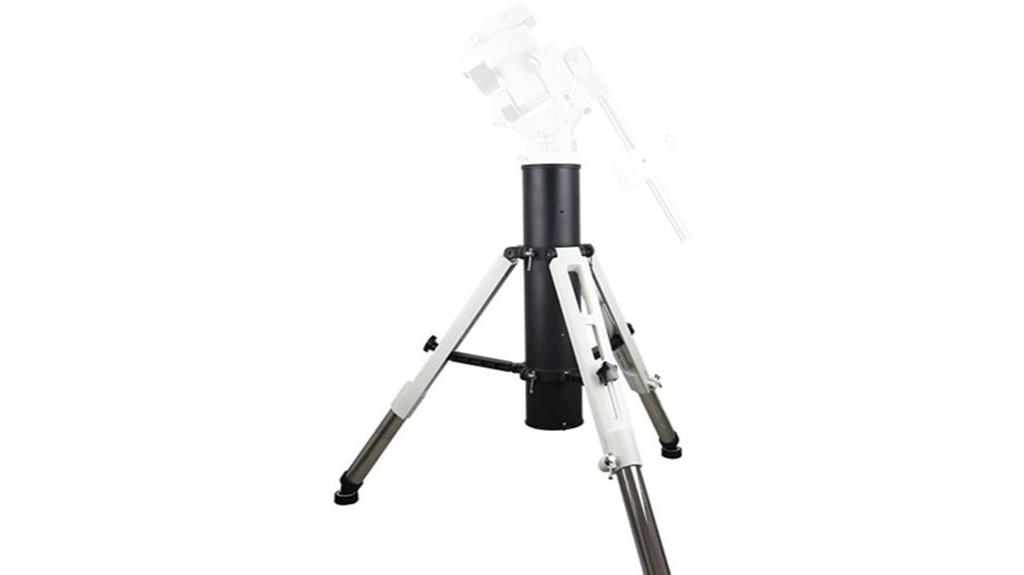
The iOptron Tri-Pier stands out as an excellent choice for astronomers who need a stable, versatile platform for their GoTo mounts. It supports up to 220 pounds, ensuring steady observations with minimal vibrations. Despite its robust build, it’s lightweight at just 25.8 pounds, making it portable and easy to transport. Its adjustable height from 31.5 to 42.5 inches allows for comfortable viewing on different terrains, even uneven ground. With a 5.7-inch pier diameter and compatibility with various mounts, it offers flexible use. Overall, the Tri-Pier combines stability, portability, and adaptability, making it ideal for outdoor astrophotography sessions.
Best For: astronomers and astrophotographers seeking a stable, portable platform for their GoTo mounts on varied terrains.
Pros:
- Supports up to 220 lbs for maximum stability during observations.
- Lightweight and portable at only 25.8 lbs, easy to transport and set up.
- Adjustable height from 31.5 to 42.5 inches for comfortable viewing on different terrains.
Cons:
- The 3.35-inch uneven ground range may limit stability on highly uneven surfaces.
- Folding dimensions of 12.8 x 26 inches might require ample storage space.
- Compatibility may vary with some specialized or larger telescope systems.
Vortex Optics Mountain Pass Tripod Kit
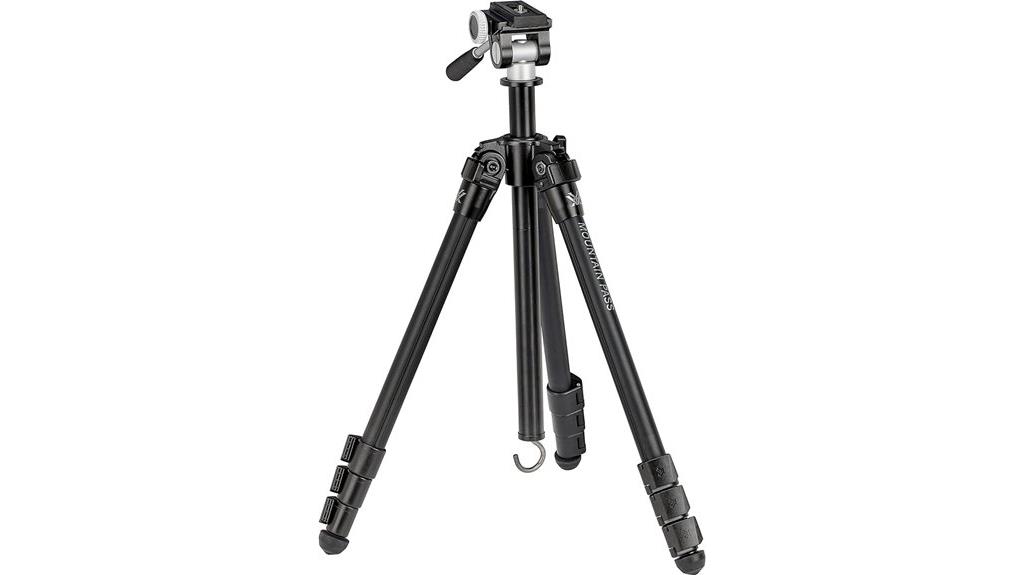
Designed for outdoor enthusiasts who need a reliable and portable tripod, the Vortex Optics Mountain Pass Tripod Kit offers a sturdy yet lightweight solution that supports up to 22 pounds. Made from machined aluminum, it balances durability with packability, making it ideal for wildlife watching, hunting, or astrophotography. Its telescoping legs with independent adjustment and quick-lock levers ensure stable, smooth operation. The two-way pan and tilt head is compatible with Arca-Swiss quick-release systems, providing secure mounting for cameras and optics. Weighing just 3.6 pounds, it’s easy to carry and highly rated for stability, build quality, and versatility.
Best For: outdoor enthusiasts, hunters, wildlife watchers, and photographers seeking a portable, durable tripod that can support heavy optics and cameras.
Pros:
- Sturdy machined aluminum construction provides durability and stability.
- Supports up to 22 pounds, accommodating larger optics and cameras.
- Telescoping legs with independent adjustment and quick-lock levers for smooth, customizable setup.
Cons:
- Weighs 3.6 pounds, which may be slightly heavy for ultra-light backpackers.
- Limited color options, primarily available in black.
- The two-way pan and tilt head may require additional accessories for advanced photography needs.
NEEWER 74″ Video Tripod Monopod with 3-Way Pan Tilt Head

If you’re looking for a versatile and budget-friendly option to enhance your astrophotography setup, the NEEWER 74″ Video Tripod Monopod with 3-Way Pan Tilt Head is an excellent choice. It’s made from lightweight aluminum, weighing just 3.9 pounds, and folds compactly for easy transport. The adjustable height from 23.6 to 74.4 inches suits various shooting angles. Its 3-way pan tilt head allows smooth horizontal and vertical movements, perfect for framing stars or planets. Plus, the built-in handle, bubble level, and nonslip rubber feet ensure stability on different terrains. The tripod supports cameras, smartphones, and action cams, making it a flexible tool for astrophotography.
Best For: hobbyist photographers, vloggers, and astrophotographers seeking a lightweight, versatile, and budget-friendly tripod for various shooting scenarios.
Pros:
- Lightweight aluminum construction (3.9 lbs) for easy portability and transport
- Adjustable height range from 23.6″ to 74.4″ to suit different shots and angles
- 3-way pan tilt head provides smooth horizontal and vertical movement for precise framing
Cons:
- Weighs slightly more than some ultra-lightweight tripods, which may affect portability for some users
- Limited maximum load capacity (17.6 lbs), not suitable for very heavy professional cameras
- Basic design may lack advanced features found in higher-end tripods, such as rapid leg locks or carbon fiber materials
Sky-Watcher Star Adventurer GTI Mount Kit with Counterweight and Tripod

For astrophotographers seeking a compact and versatile mount, the Sky-Watcher Star Adventurer GTI Kit with Counterweight and Tripod offers an excellent solution. Introduced in 2014 and upgraded with full GoTo capability, it features an illuminated polar scope for precise alignment, Wi-Fi connectivity, and multiple tracking rates for lunar, solar, and deep space imaging. The kit includes a sturdy tripod, counterweight bar, and dual-position counterweight, supporting payloads up to 11 pounds. Its lightweight design (around 26 pounds) and portable size make it perfect for on-the-go astrophotography. With smartphone control and compatibility with small telescopes and cameras, it’s a versatile choice for both beginners and experienced astrophotographers.
Best For: amateur and professional astrophotographers seeking a portable, versatile mount capable of precise tracking and compatibility with various cameras and small telescopes.
Pros:
- Compact, lightweight design for easy transport and setup.
- Full GoTo capability with Wi-Fi control and illuminated polar scope for accurate alignment.
- Supports multiple tracking rates for lunar, solar, and deep space imaging, accommodating a variety of astrophotography needs.
Cons:
- Payload capacity limited to 11 pounds, which may restrict the size of equipment used.
- May require additional accessories or adapters for certain camera or telescope setups.
- Slightly higher price point compared to basic mounts without advanced features.
iOptron Mini Pier Tripod Extension for Mounts

The iOptron Mini Pier Tripod Extension is an excellent choice for astrophotographers seeking enhanced stability and precise alignment. It minimizes vibrations, providing a steadier platform for clearer images and better observations. Made from durable materials, it features multiple hex head screws (M8 & M10) and a M12 center bolt to ensure a secure setup. Raising the mount by 8 inches improves viewing angles and prevents ground obstructions. Compatible with iOptron MiniTower series mounts, it includes an iEQ45 center stud and alignment pegs, making polar alignment easier and more accurate. This extension truly elevates your astrophotography experience with increased stability and precision.
Best For: amateur and professional astrophotographers seeking to enhance stability, precision, and viewing angles for their telescope setups.
Pros:
- Minimizes vibrations for clearer images and more stable observations
- Elevates the mount by 8 inches for improved viewing angles and ground clearance
- Compatible with multiple iOptron MiniTower series mounts for versatile use
Cons:
- May require additional tools for installation due to multiple hex screws and bolts
- Limited to use with specific mounts (MiniTower series and compatible models)
- May add weight and bulk to the overall setup, affecting portability
DaVoice 44mm Tripod Quick Release Plate Camera Mounting Adapter
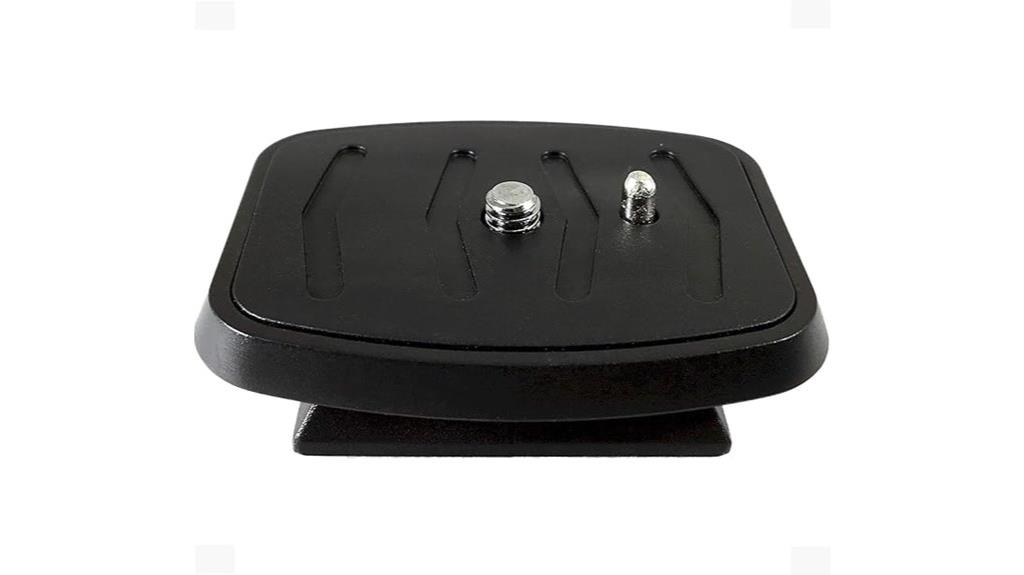
Photographers seeking quick and secure camera setup will appreciate the DaVoice 44mm Tripod Quick Release Plate Adapter, especially when working with compatible tripods like Amazon Basics or Velbon. This plate features a tapered square base measuring 44mm, fitting into tripod mounts with openings of 1 3/4” (44mm x 44mm). Made from durable plastic with a rubber top, it ensures a firm grip and slippage prevention. The metal pin and thumb screw allow tool-free, fast attachment and detachment, making setup efficient. It’s a reliable replacement for Amazon Basic plates and supports multi-camera setups, perfect for quick, secure, and versatile astrophotography sessions.
Best For: photographers and videographers needing quick, secure, and versatile camera mounting solutions on compatible tripods like Amazon Basics and Velbon.
Pros:
- Easy tool-free attachment with metal thumb screw and metal pin for quick setup.
- Durable plastic construction with rubber top for secure grip and slip prevention.
- Compatible with multiple tripod brands and supports multi-camera configurations.
Cons:
- Compatibility limited to tripods with 44mm x 44mm square openings measuring 1 3/4”.
- May require verifying tripod head dimensions before purchase.
- Plastic build, while durable, may not withstand extreme conditions as well as metal alternatives.
EQ6 Tripod to Wave Steel by Sky-Watcher
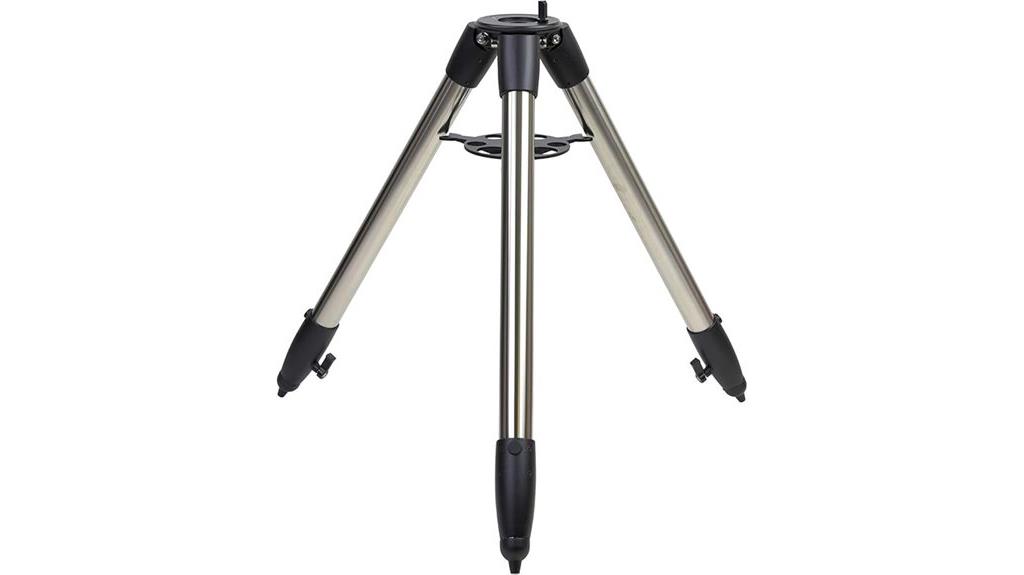
If you’re seeking a stable and durable tripod for astrophotography, the EQ6 Tripod to Wave Steel by Sky-Watcher is an excellent choice. Its robust 2-inch rolled steel legs provide exceptional stability, minimizing vibrations for sharper images and smooth tracking. Designed for Sky-Watcher Wave mounts, it’s also compatible with NEQ6, EQ6, EQ6-R, and AZ-EQ6 mounts, making it versatile. You’ll need the Wave Pier Adapter (S30916) to attach Wave mounts properly. With a sleek black finish, it offers a professional look that complements your setup. Overall, this tripod combines strength, compatibility, and style for serious astrophotographers.
Best For: astrophotographers and amateur astronomers seeking a sturdy, stable tripod compatible with Sky-Watcher Wave mounts and other popular EQ6 series mounts.
Pros:
- Robust 2-inch rolled steel legs provide excellent stability and vibration reduction
- Compatible with multiple mounts including Sky-Watcher Wave, NEQ6, EQ6, EQ6-R, and AZ-EQ6
- Sleek black finish offers a professional appearance that complements various setups
Cons:
- Requires the Wave Pier Adapter (S30916) for attachment, adding an extra component to purchase
- Heavier and potentially less portable due to its sturdy steel construction
- May be overbuilt for casual or beginner stargazing needs, making it more suitable for serious astrophotographers
iOptron SkyHunter Extension Pier and Tripod
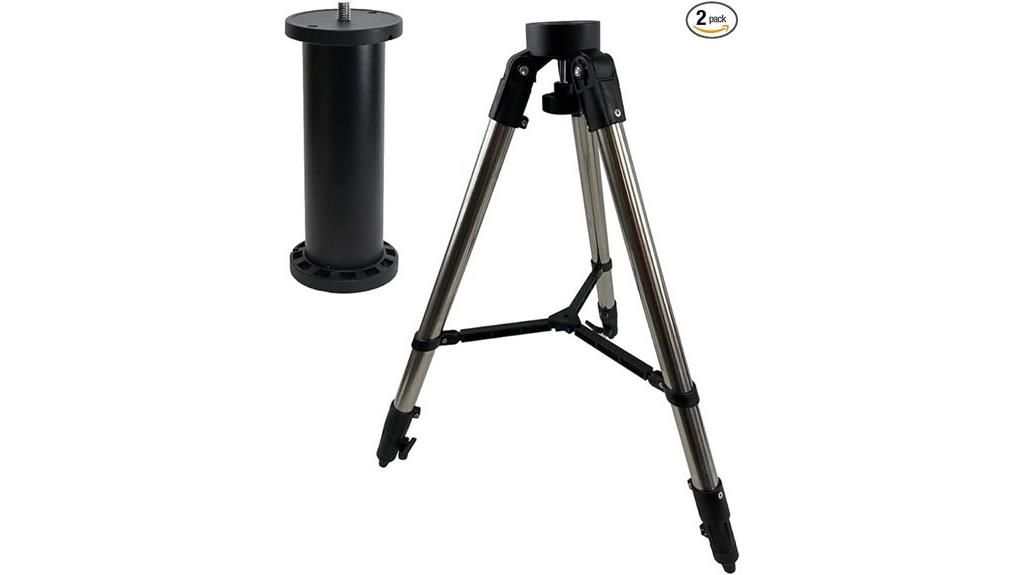
Designed for serious astrophotographers, the iOptron SkyHunter Extension Pier and Tripod offers a robust and stable platform that elevates telescopes and camera mounts with precision. Its stainless steel tripod supports SkyHunter, SkyGuider Pro, and other mounts with 3/8-16 or M6 holes, while the 7.5-inch aluminum extension pier adds height and stability. Weighing around 24 pounds, it’s built for durability and reliable performance during long sessions. The flange diameter is 82mm, and the tube diameter is 58mm, ensuring compatibility and secure mounting. This setup substantially improves viewing angles, making it a versatile choice for astrophotographers seeking stability and elevation.
Best For: serious astrophotographers and astronomers seeking a durable, stable platform for elevated telescope and camera setups.
Pros:
- Made with high-quality stainless steel and aluminum for durability and stability.
- Supports multiple mounts and cameras with compatible 3/8-16 or M6 holes.
- Offers adjustable height with a 7.5-inch extension pier for improved viewing angles.
Cons:
- Heavier weight (~24 pounds) may make transportation and setup more cumbersome.
- The size and weight could be overkill for casual or beginner astronomers.
- Premium materials and build may come with a higher price point compared to basic tripods.
Sky-Watcher AZ-GTI Portable GoTo Alt-Az Mount
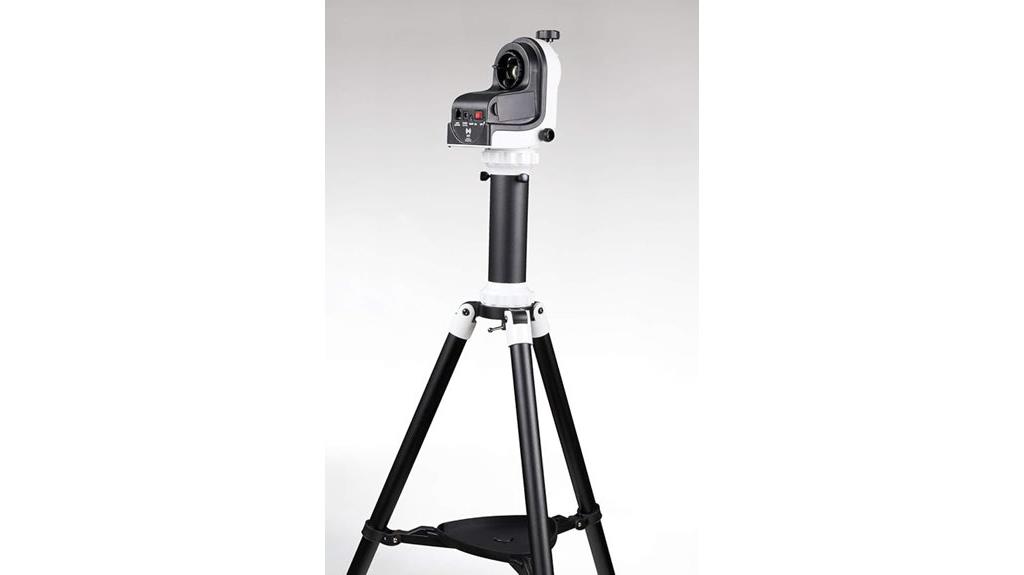
The Sky-Watcher AZ-GTI Portable GoTo Alt-Az Mount is an excellent choice for amateur astronomers who need a lightweight, portable mount that packs advanced tracking features. Weighing just 8.6 pounds, it’s perfect for travel, supporting payloads up to 11 pounds, including telescopes and DSLR cameras. Its adjustable aluminum tripod extends from 28 to 53 inches, ensuring comfortable viewing. With WiFi connectivity, you can control it via the Sky-Watcher SynScan Pro app on your smartphone or tablet, enabling remote operation, time-lapse, and panorama shots. Rugged brass and aluminum gears deliver smooth, precise tracking, making it ideal for both observation and astrophotography on the go.
Best For: amateur astronomers seeking a lightweight, portable, and feature-rich mount for observation and astrophotography on the go.
Pros:
- Compact and lightweight at only 8.6 pounds, ideal for travel and outdoor use.
- Supports up to 11-pound payloads, accommodating most telescopes and cameras.
- WiFi-enabled with app control for remote operation, time-lapse, and panorama photography.
Cons:
- Requires batteries or external power sources for operation, which may need additional accessories.
- May have limited payload capacity for larger telescopes or heavy astrophotography equipment.
- As an alt-az mount, it may not be ideal for long-exposure astrophotography compared to equatorial mounts.
NEEWER 72-inch Camera Tripod with Monopod and Ball Head

The NEEWER 72-inch Camera Tripod with Monopod and Ball Head stands out as an ideal choice for photographers seeking versatile stability and quick adjustments. Its sturdy aluminum alloy build supports up to 33 pounds, making it suitable for heavy cameras and accessories. The multi-angle center column allows for both vertical and horizontal shots, while removable legs enable conversion to a monopod. The panoramic ball head with quick release lets me adjust my composition swiftly. With adjustable legs, bubble levels, and overhead mounts, this tripod is perfect for astrophotography, offering stability and flexibility for capturing the night sky like a pro.
Best For: photographers and videographers who need a versatile, stable tripod that can handle heavy equipment and offers quick adjustments for various shooting angles.
Pros:
- Supports up to 33lb/15kg, suitable for heavy cameras and accessories
- Multi-angle center column for vertical, horizontal, and macro shots
- Converts into a monopod for increased shooting flexibility
Cons:
- Slightly heavier than lightweight tripods, which may affect portability
- Aluminum construction can be prone to scratches or dents with rough handling
- Complex adjustment features may require some time to master for beginners
iEXOS-100-2 PMC-Eight Astrophotography Tracker System with Tripod and Mount
If you’re serious about astrophotography and need precise tracking, the iEXOS-100-2 PMC-Eight System with its advanced eight-CPU setup is an excellent choice. It offers superior responsiveness, efficiency, and reliability, thanks to its integrated PMC-Eight system. The system features quiet, smooth dual-axis worm gears, belt drives, and intuitive operation via the ExploreStars app, compatible with multiple devices. It simplifies star alignment, celestial navigation, and learning about objects in the night sky. Weighing only 20 pounds, it includes a sturdy tripod and mount, making it ideal for fast setup and accurate tracking during long exposures.
Best For: astrophotographers and astronomy enthusiasts seeking precise, reliable tracking systems for long-exposure imaging and celestial navigation.
Pros:
- Advanced eight-CPU system offers superior responsiveness and efficiency
- Quiet, smooth dual-axis worm gears and belt drives ensure accurate tracking with minimal noise
- Compatible with ExploreStars app for easy operation, star alignment, and celestial learning
Cons:
- Relatively heavy at 20 pounds, which may affect portability for some users
- Requires familiarity with astrophotography equipment and app operation for optimal use
- Higher price point may be a consideration for casual or beginner astronomers
Sky Watcher Star Adventurer GTI Mount Kit with Counterweight and CW Bar

For astrophotographers seeking a portable mount with advanced tracking and GoTo capabilities, the Sky Watcher Star Adventurer GTI Mount Kit with Counterweight and CW Bar stands out as an excellent choice. It offers full GoTo functionality, built-in Wi-Fi, and an illuminated polar scope for precise alignment. The dual-position counterweight bar suits low latitudes, and its lightweight design—around 15 pounds—makes it ideal for field use. With an 11-pound payload capacity, it handles DSLR or small telescopes. The V-style dovetail and versatile ports allow easy setup, making it perfect for capturing deep-sky objects, the Moon, or planets on the go.
Best For: astrophotographers seeking a lightweight, portable mount with advanced GoTo and tracking features for deep-sky, lunar, and planetary imaging.
Pros:
- Full GoTo functionality with built-in Wi-Fi for automated object locating and control
- Illuminated polar scope and multiple tracking modes for precise alignment and versatile imaging
- Compact, lightweight design with an 11-pound payload capacity, ideal for field use and travel
Cons:
- Limited to a 15-pound payload capacity, may not support larger telescopes or heavy gear
- Compatibility restricted to smaller DSLR or mirrorless cameras and small telescopes, not suitable for heavy astrophotography setups
- Requires a smartphone or compatible device for operation if not using the optional SynScan hand controller
Sky-Watcher AZ5 Telescope Mount

Looking for a reliable mount that’s perfect for beginners delving into astrophotography or terrestrial observations? The Sky-Watcher AZ5 Telescope Mount is a lightweight, all-metal option that offers stability and ease of use. It supports up to 15 pounds and features a sturdy steel tripod with adjustable legs for uneven surfaces. Its geared slow motion controls allow precise manual tracking, which is great for beginners. Constructed from durable cast aluminum, it’s easy to transport and compatible with various optical tubes. With a compact size and positive reviews, the AZ5 is a versatile, user-friendly mount ideal for those starting their astrophotography journey.
Best For: beginners interested in astrophotography or terrestrial viewing seeking a stable, lightweight, and easy-to-use mount.
Pros:
- Supports payloads up to 15 pounds, suitable for a variety of optical tubes
- Features geared slow motion controls for precise manual tracking
- Durable all-metal construction with adjustable tripod legs for uneven surfaces
Cons:
- Weighs approximately 12 pounds, which may be less portable for some users
- Limited to manual operation without motorized tracking capabilities
- Compatibility depends on a 45mm Vixen-style dovetail, which may require adapters for some accessories
Factors to Consider When Choosing Tripods and Pier Mounts for Astrophotography

When choosing a tripod or pier mount for astrophotography, I focus on stability and vibration control to guarantee clear images. I also consider how portable it is and whether it can support my equipment comfortably at different heights. Finally, I check that it’s compatible, durable, and made from quality materials to last through many sessions.
Stability and Vibration Control
A stable tripod or pier mount is essential for capturing sharp astrophotography images, as even slight vibrations can cause blurring during long exposures. To achieve this, I look for materials like aluminum, steel, or carbon fiber, which absorb vibrations effectively. Tripods with adjustable leg locks and reinforced joints provide a rigid platform, reducing unwanted movement. Using vibration suppression pads, weights, or leveling tools on uneven ground further enhances stability. Heavy-duty tripods and pier mounts with higher weight capacities are better at absorbing external shocks, maintaining steadiness during detailed imaging sessions. I prioritize sturdy construction and additional stability features because consistent, vibration-free setups are pivotal for capturing clear, crisp images of the night sky.
Weight and Portability
Choosing the right tripod or pier mount involves balancing weight and portability. Lighter gear is easier to carry and set up in remote locations, making it ideal for field sessions. However, increased weight can improve stability by reducing vibrations, which is vital for precise star tracking. The challenge is finding a design that’s lightweight yet stable enough for long exposures. Many portable tripods feature collapsible or adjustable legs, allowing compact storage and easier transport without sacrificing support. It’s also important that the equipment’s weight capacity matches or exceeds your gear’s weight to prevent tipping and ensure stable imaging. Ultimately, the goal is to select a lightweight setup that provides enough support for accurate astrophotography, enabling you to capture the night sky with confidence and ease.
Adjustability and Height
Ever wonder how the height adjustability of a tripod or pier mount can impact your astrophotography sessions? It’s essential for finding the perfect viewing angle and ensuring stable framing of celestial objects. Adjustable models often feature telescoping legs or extension components, giving you a wide range—some from about 23 inches to over 74 inches—so you can tailor the height to your needs. Precise control over height helps you align your equipment accurately and avoid ground obstructions, which is especially important on uneven terrain. Quick-adjust mechanisms like twist locks or levers make it easy to change heights on the fly, saving time and effort during setup. Fine-tuning height not only improves comfort but also enhances the stability and precision of your astrophotography.
Compatibility With Equipment
When selecting a tripod or pier mount for astrophotography, it’s vital to guarantee compatibility with your equipment’s mounting requirements. First, check that the mount has the right attachment points, like Vixen-style dovetails or 3/8-16 threads, to fit your gear securely. Be sure the weight capacity can support your camera, telescope, and accessories without sacrificing stability. Verify the hole sizes and spacing match your mounting hardware, including counterweights or extension bars. It’s also important to confirm the mount supports necessary tracking and movement features, such as motorized or manual slow-motion controls, for precise tracking. Finally, confirm compatibility of control interfaces—Wi-Fi, Bluetooth, or autoguider ports—with your existing accessories and software. Proper compatibility guarantees smooth operation during your astrophotography sessions.
Durability and Material
Durability and material quality are crucial factors because they directly influence the stability and longevity of your astrophotography equipment. High-quality materials like stainless steel or aluminum offer excellent durability and resistance to corrosion, which is essential for outdoor use. The strength of these materials determines the load capacity and stability, critical for capturing sharp images during long exposures. Durable materials also prevent flexing or warping under weight or environmental stress, helping maintain precise alignment. While heavier construction increases overall weight, it provides better vibration damping, resulting in clearer images. Additionally, choosing weather-resistant materials ensures your equipment withstands outdoor conditions, prolonging its lifespan and ensuring reliable performance night after night. Durability and quality materials are truly the backbone of stable, long-lasting astrophotography gear.
Ease of Setup
Choosing the right tripod or pier mount for astrophotography hinges considerably on ease of setup, as it can save you valuable time during night sessions. Look for models with quick-release mechanisms, which make assembling and disassembling fast and hassle-free. Adjustable height features are also essential, allowing you to find the perfect observing position quickly and easily. Clear, intuitive leveling and alignment tools help guarantee precise positioning without guesswork. Additionally, lightweight materials like aluminum or carbon fiber balance portability with stability, making setup less cumbersome. Finally, user-friendly designs or detailed instructions can simplify assembly for both beginners and experienced users. Prioritizing ease of setup helps maximize your observing time and minimizes frustration when working under a time-sensitive night sky.
Terrain Adaptability
Selecting a tripod or pier mount that adapts well to different terrains can make or break your astrophotography session. Adjustable legs or feet are vital for achieving stability on uneven or rocky ground. Tripods with wide-set or spiked feet offer better grip and prevent slipping on loose or soft surfaces, which is essential in the field. Compatibility with terrain-specific accessories, like ground anchors or sandbag weights, enhances stability in challenging environments. Lightweight, portable mounts allow for quick setup and easy adjustments across various terrain types. Additionally, robust constructions with reinforced joints and durable materials help maintain stability and alignment on rugged or sloped surfaces. Prioritizing terrain adaptability ensures your gear stays steady, so you can focus on capturing clear, sharp night sky images without worry.
Frequently Asked Questions
How Do Tripod Weight and Stability Affect Astrophotography Quality?
Tripod weight and stability are vital for astrophotography because they directly influence image sharpness. A heavier tripod resists vibrations caused by wind or movement, ensuring steady shots. Stability allows me to capture long exposures without star trails or blurring. I always choose a sturdy, well-built tripod and avoid lightweight options, knowing that solid support makes the difference between a blurry mess and stunning, crisp night sky images.
What Are the Best Materials for Durable, Lightweight Astrophotography Tripods?
Aluminum and carbon fiber are the top materials for durable, lightweight astrophotography tripods. I’ve found carbon fiber to be especially impressive—it’s sturdy yet markedly lighter than aluminum, reducing fatigue during long shoots. Many professionals swear by it for stability and portability. While aluminum is more affordable and still durable, if you want the best balance of strength and weight, I recommend investing in a high-quality carbon fiber tripod.
How Does Weather Resistance Impact Tripod Performance in Night Sky Imaging?
Weather resistance is vital for tripod performance in night sky imaging because it protects my gear from moisture, dust, and temperature fluctuations. When I shoot in unpredictable conditions, a weather-resistant tripod ensures stability and durability, minimizing vibrations or damage. It allows me to focus on capturing clear, sharp images without worrying about environmental factors. Fundamentally, good weather resistance keeps my equipment reliable, no matter what the night throws at me.
Can Adjustable Height Features Improve Astrophotography Setup Flexibility?
Absolutely, adjustable height features can boost your astrophotography setup flexibility. I find that being able to tweak the tripod height easily helps me get the perfect angle for different sky regions and equipment. It also makes setup and breakdown smoother, especially in uneven terrain. Plus, it allows me to adapt quickly to changing conditions or when working with various telescopes and cameras, ensuring I get stable, clear shots every time.
What Maintenance Tips Ensure Longevity of Astrophotography Tripod Equipment?
To keep my astrophotography tripod in top shape, I always clean the legs after each shoot, especially if I’ve been in dusty or humid conditions. For example, I once noticed corrosion developing on my aluminum tripod’s joints, so I applied a light coating of silicone spray to prevent rust and keep it smooth. Regular maintenance like this guarantees my gear stays durable and reliable for those perfect night sky shots.
Conclusion
Choosing the right tripod or pier mount is like finding the perfect dance partner for your astrophotography journey. It guarantees stability, ease of use, and sharp images of the night sky. Whether you’re a beginner or pro, investing in quality gear makes all the difference. So, take your time, consider your needs, and remember—your setup should hold steady like a rooted tree, so you can truly capture the cosmos without wobbling.
